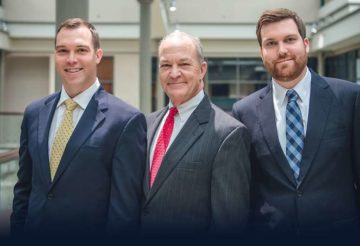Following a bicycle accident, victims may be able to claim compensation if they sustained injuries and other damages and another party's improper conduct caused the accident. The amount and type of compensation that victims may recover will depend on several factors concerning the accident and the damages sustained. The best way to determine your legal options is to speak with an experienced and knowledgeable bicycle accident lawyer.
How Often Do Bicycle Accidents Take Place?
Bicycle accidents are commonplace, often resulting in serious injuries and fatalities. Unlike other types of vehicle accidents, bicyclists have far less protection to keep them safe from harm during an accident. As a result, bicyclists are more vulnerable to injuries if they collide with a motor vehicle.
According to the Centers for Disease Control and Prevention (CDC), bicyclists comprise around 2 percent of fatalities resulting from motor vehicle accidents. Specifically, in the U.S., 1,000 bicyclists die, and more than 130,000 sustain injuries in accidents yearly. One recent report found that 61 percent of bicyclist deaths occurred on major roads, not including freeways and interstates in a single year. Another 33 percent took place on minor roads.
Cyclists should wear helmets and protective gear to reduce the risk of accidents, but there’s no guarantee these measures will protect them. In many cases, other parties, including other drivers, are responsible for bicycle accidents through negligence or malicious acts.
The Different Types of Bicycle Accidents
Many types of bicycle accidents can result in serious injuries or deaths. The following are some of the most common types of bicycle accidents that occur:
Right Cross Bicycle Accidents
The right-cross bike accident is among the most common bicycle accidents. This accident involves vehicles pulling out from the right side of driveways, streets, or parking areas. While pulling out, the driver may collide with the bicyclist, or the bicyclist may hit the left side of the vehicle.
Left Cross Bicycle Accidents
Like the right cross accident, a left cross bicycle accident involves the motorist turning and hitting a bicyclist. In these accidents, the motor vehicle comes from the opposite direction of the bicyclist when making a left turn, colliding with the bicyclist or vice versa.
Riding Against Traffic
Another common type of bicycle accident involves bicyclists riding against oncoming traffic. These accidents result when an oncoming vehicle hits the cyclist when completing a right turn. This is why bicyclists should ride with traffic instead of against it.
Right Hook Bicycle Accidents
Right hook bike accidents occur when bicyclists ride with traffic, and a motorist hits the bicyclist as they make a right turn in front of the bicycle. Often, these accidents occur when the bicyclist is in the blind spot or the motorist didn't notice the bicyclist. Some accidents may occur when the motorist mistakenly believes they've already passed the bicyclist and are far enough ahead.
Door Bicycle Accidents
Bicyclists may also get into accidents involving car doors. These accidents occur when a vehicle occupant opens their door as a bicyclist passes, causing the bicyclist to hit the door. They may occur when riding on either side of the vehicle, with many involving bicyclists hitting doors while riding along a bike path or on a sidewalk. Some cases also involve motorists who simply left their doors open and bicyclists who fail to see the door in time to avoid it.
Rear-End Bicycle Accidents
A rear-end accident involving a bike often occurs when a cyclist rides on the far right side of the lane, which may force the bicyclist to move to the left if they encounter an obstacle in the road, such as a parked car. When moving left into traffic, a vehicle behind the bicyclist may inadvertently rear-end the bicyclist.
Rear-end accidents may also involve bicyclists tailing too close behind a vehicle and failing to break in time before hitting the back of the motor vehicle. For instance, a bicyclist may hit a vehicle from behind when a vehicle in front stops for a red light, stop sign, or an emergency.
Red Light Bicycle Accidents
These accidents may occur when a bicyclist stops to the right of a stopped vehicle at a red light. Once the light changes to green, the vehicle may turn right and collide with the bicyclist. This accident risk makes it important for bicyclists to stop behind waiting vehicles at red lights or stop signs.
Road Rage
Some bicycle accidents may not result from negligence. Road rage could lead motorists to intentionally hit a bicyclist, often when the motorist perceives the bicycle as an obstacle slowing them down.
These are some of the main causes of bicycle accidents, which can involve negligence or other improper conduct by motorists, bicyclists, or even third parties. Depending on who was liable and the specific damages involved, victims may be able to file a claim or lawsuit for compensation.
Determining Liability Following a Bicycle Accident
In the event of a bicycle accident, various parties may be responsible. In most accidents, the motorist is liable due to the rule of negligence per se.
Normally, plaintiffs would need to prove several key elements to succeed in negligence cases such as car accidents involving only motorists.
These items include:
- That the defendant owed a duty of care to the plaintiff
- That the defendant breached that duty of care
- That the accident wouldn’t have taken place if the breach of duty of care hadn’t occurred
- That the defendant’s negligence directly contributed to the injuries and other damages the victim sustained
Meanwhile, in a negligence per se case, the plaintiff must prove three main elements: That the driver violated a traffic safety law, that this violation contributed to the accident and injuries, and that the victim sustained certain compensable damages.
When a Third-Party Is Liable?
Some cases may involve a third party who isn’t the motorist or bicyclist.
There are several main circumstances when a third party may need to compensate victims in a bicycle accident case.
These include:
- Alcohol Supplier Negligence - In accidents involving a drunk driver who collides with a bicyclist, the supplier of the alcohol may be responsible for the damages.
- Negligent Entrustment - In these cases, accidents may involve motorists driving for their employer. The employer would be liable for the accident if they neglected to supervise and monitor their employee sufficiently.
- Respondeat Superior - If an accident involves a motorist employee driving within the scope of their employment, their employer may also be liable for some of the damages in these instances.
- The Liability of the City or County - Defects on the roads may also lead to bicycle accidents. For example, a pothole may cause the bicyclist to lose control and crash. If the city or county failed to address this issue when they should have, this party might be liable.
If a negligent party contributed to a bicycle accident, victims can recover compensation for their damages.
The Potential Kinds of Compensation Bicycle Victims May Recover
Following a bicycle accident, victims may pursue different compensation based on their sustained damages. These can include certain types of economic and non-economic damages.
Economic Damages
Bicycle accident victims may recover several economic damages:
- Medical Expenses - Bicycle accidents often involve serious injuries that require treatment. If injuries result in medical treatment, including immediate and ongoing care, victims may be able to receive compensation for these costs. This compensation may come into play regardless of the injuries sustained.
- Lost Income - Some injuries may require the victim to take time off work to recover fully. Others may be permanently unable to work because of disability. In either case, victims may seek compensation for the loss of income they experienced because of their injuries.
- Property Damage - Many bicycle accidents also involve property damage, often due to the lack of protection for bicyclists’ belongings when riding. Some items that could sustain damage in these accidents may include the bicycle, phones, protective gear, and glasses.
Non-Economic Damages
Bicycle accidents also frequently involve non-economic damages that aren’t as easy to calculate as economic damages. These are highly subjective and vary from victim to victim based on personal experience. Physical injuries often cause pain and suffering that can count toward non-economic damages.
Pain and suffering may involve physical or psychological distress resulting from an accident. For instance, victims may experience great pain when recovering, which they can document in a pain journal. They may also suffer from trauma, depression, anxiety, or other forms of mental anguish. While these damages don’t come with a specific dollar amount attached to them, they could contribute to the total amount of compensation in a case.
Punitive Damages
If a motorist or other party acted unusually negligent or malicious when causing an accident, they might need to pay punitive damages. The court rarely awards these; they’re solely for punishing the defendant rather than compensating the victim. The goal is to set an example and prevent similar improper conduct.
Steps for Recovering Compensation in a Bicycle Accident Case
After a bicycle accident and the beginning of the recovery process, victims may begin seeking compensation for the damages they suffered. Normally, this entails filing either an insurance claim or a lawsuit against the liable parties.
When to File Insurance Claims?
Many bicycle accidents lead to insurance claims, which may compensate victims for medical costs, lost income, and property damage resulting from the collision. While these claims may cover the base economic damages, they won’t typically account for non-economic damages on the same level as a lawsuit.
Insurance payouts may help cover a certain amount of pain and suffering, but insurance companies work hard to avoid paying too much compensation to victims. If injuries, pain, and suffering don't warrant large amounts of compensation, it's often best to file an insurance claim.
Insurance adjusters are only on the insurer’s side. To avoid minimizing the amount of compensation you may be able to recover, you may want to consult with a bicycle accident lawyer who has experience negotiating with insurers. Doing so can help you avoid making statements that might otherwise reduce compensation or result in claim denial.
When to File a Lawsuit?
If a case involves serious injuries and costly damages, the right step may be to file a lawsuit against the negligent parties responsible. There are a few circumstances when filing a lawsuit may be the best move. For instance, the party responsible may not cooperate during the negotiation of a claim. Some cases may also involve insurance companies that fail to pay out what the victim truly deserves. Others may involve uninsured motorists.
If you decide to file a lawsuit, it’s in your best interest to consult with a bicycle accident attorney to determine if you have a case and can seek legal action. They can also provide representation and help navigate the case, from evidence collection and presentation to hiring professionals to recreate the events of the accident.
Speak With a Bike Accident Lawyer to Discuss Compensation

Have you or a loved one been in a bicycle accident and wish to recover compensation? You may have a case that warrants compensation for various damages if you believe another party’s negligence led to the accident. The best way to determine your options is to speak with an experienced and knowledgeable bicycle accident lawyer.
The right attorney will help determine whether you can file a claim or lawsuit to recover damages. You may recover compensation for a combination of economic and non-economic damages or even punitive damages.
To find out whether you have a case, contact bike accident lawyer today.


